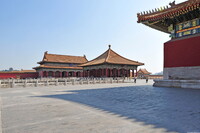| dc.coverage.spatial | Site: Forbidden City (Beijing, Beijing Shi (municipality), China) | en_US |
| dc.coverage.temporal | 1420 (creation) | en_US |
| dc.creator | unknown (Chinese) | en_US |
| dc.date | 1420 | en_US |
| dc.date.accessioned | 2013-08-07T18:19:06Z | |
| dc.date.available | 2013-08-07T18:19:06Z | |
| dc.date.issued | 1420 | en_US |
| dc.identifier | 229391 | en_US |
| dc.identifier.other | archrefid: 2347 | en_US |
| dc.identifier.uri | http://hdl.handle.net/1721.3/137175 | |
| dc.description | Context view, looking northeast showing the location between the Hall of Supreme Harmony (right) and the Hall of Preserving Harmony (left); The Forbidden City was the Chinese imperial palace from the Ming Dynasty to the end of the Qing Dynasty. The five-by-five bay Hall of Middle Harmony (Zhonghe dian), built in 1420 in the form of a square pavilion, was a minor throne hall where the emperor rested before the great ceremonies. The light construction of this hall contrasts to the heavy ponderousness of the two on either side of it: only 256 sq. m in area, it is surrounded by an open colonnade, and all four walls have lattice window and door panels to allow light into the interior. Its name comes from a phrase in the Book of Changes that admonishes one to stay close to the mean (middle), avoiding all extremes.
Source: Grove Art Online; http://www.oxfordartonline.com/ (accessed 5/10/2011) | en_US |
| dc.format.medium | brick; stucco; tile; painted wood | en_US |
| dc.rights | © Scott Gilchrist, Archivision, Inc. | en_US |
| dc.subject | architecture | en_US |
| dc.subject | decorative arts | en_US |
| dc.subject | historical | en_US |
| dc.subject | rulers and leaders | en_US |
| dc.subject | Chinese | en_US |
| dc.subject | Ming | en_US |
| dc.subject | Qing | en_US |
| dc.title | Forbidden City: Hall of Middle Harmony (Zhong He Dian) 中和殿 | en_US |
| dc.title.alternative | Hall of Middle Harmony (Zhonghe dian) | en_US |
| dc.type | image | en_US |
| dc.rights.access | Licensed for educational and research use by the MIT community only | en_US |
| dc.identifier.vendorcode | 1A2-CH-B-FC-HMH-A1 | en_US |
| vra.culturalContext | Chinese | en_US |
| vra.technique | carving (processes), construction (assembling), painting and painting techniques | en_US |
| vra.worktype | historic site | en_US |
| vra.worktype | capital city | en_US |
| vra.worktype | reception room | en_US |
| dc.contributor.display | unknown (Chinese) | en_US |


